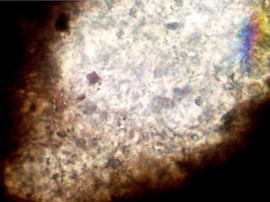 India Ink Showing Excessive EPS in Floc
India Ink Showing Excessive EPS in Floc We see viscous bulking when the bacteria begin to produce excessive quantities of extracelluar polysaccharides (EPS). In normal good floc, it is the EPS that acts as the glue to hold bacteria cells and adsorbed (outside cell wall) particles. When cells begin to overproduce the EPS, the previous glue begins to hold excessive amounts of water and is very vulnerable to sheer. The resulting sludge does not compact well and can easily be carried over secondary weirs. The return sludge (RAS) concentration is lower as we are returning more water relative to biological solids which further compounds the problem.
You can see viscous bulking under normal light microscopy as "fingers" and gelatinous appearance. The appearance can be enhanced for better observation by adding India Ink to the slide. The India Ink will not penetrate the EPS and will appear as clear zones around the floc.
Causes of Viscous Bulking
- Lack of a vital macronutrient (Nitrogen or Phosphorus)
- Micronutrients (Fe, Mg, etc) being deficient
- Excess influent organic acids usually from anaerobic activity
- High fat, oil & grease loadings
- Temperature stress
- Check nutrients and add as necessary
- Increase wasting to rid system of existing viscous floc
- In severe cases, we often couple wasting with seeing cultures (bioaugmentation). In this case we use cultures with excellent floc forming characteristics and often seed with strains capable of producing cationic EPS versus the more common anionic EPS.

 RSS Feed
RSS Feed